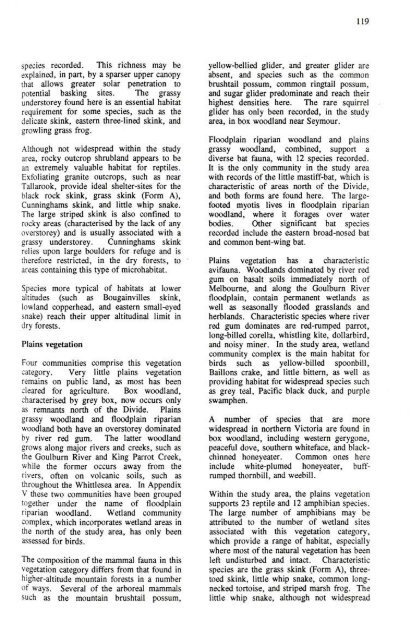Factors Affecting Flora Conservation - Victorian Environmental ...
Factors Affecting Flora Conservation - Victorian Environmental ...
Factors Affecting Flora Conservation - Victorian Environmental ...
You also want an ePaper? Increase the reach of your titles
YUMPU automatically turns print PDFs into web optimized ePapers that Google loves.
119<br />
species recorded. This richness may be<br />
explained, in part, by a sparser upper canopy<br />
that allows greater solar penetration to<br />
potential basking sites. The grassy<br />
understorey found here is an essential habitat<br />
requirement for some species, such as the<br />
delicate skink, eastern three-lined skink, and<br />
growling grass frog.<br />
Although not widespread within the study<br />
area, rocky outcrop shmbiand appears to be<br />
an extremely valuable habitat for reptiles.<br />
Exfoliating granite outcrops, such as near<br />
Tallarook, provide ideal shelter-sites for the<br />
black rock skink, grass skink (Form A),<br />
Cunninghams skink, and little whip snake.<br />
The large striped skink is also confined to<br />
rocky areas (characterised by the lack of any<br />
overstorey) and is usually associated with a<br />
grassy understorey. Cunninghams skink<br />
relies upon large boulders for refuge and is<br />
therefore restricted, in the dry forests, to<br />
areas containing this type of microhabitat.<br />
Species more typical of habitats at lower<br />
altimdes (such as Bougainvilles skink,<br />
lowland copperhead, and eastern small-eyed<br />
snake) reach their upper altltudinal limit in<br />
dry forests.<br />
Plains vegetation<br />
Four communities comprise this vegetation<br />
category. Very little plains vegetation<br />
remains on public land, as most has been<br />
cleared for agriculture. Box woodland,<br />
characterised by grey box, now occurs only<br />
as remnants north of the Divide. Plains<br />
grassy woodland and floodplain riparian<br />
woodland both have an overstorey dominated<br />
by river red gum. The latter woodland<br />
grows along major rivers and creeks, such as<br />
the Goulburn River and King Parrot Creek,<br />
while the former occurs away from the<br />
rivers, often on volcanic soUs, such as<br />
throughout the Whittiesea area. In Appendix<br />
V these two communities have been grouped<br />
together under the name of floodplain<br />
riparian w(X)dland. Wetland community<br />
complex, which incorporates wetland areas in<br />
die north of the stutiy area, has only been<br />
assessed for birds.<br />
The composition of the mammal fauna in this<br />
vegetation category differs from that found in<br />
higher-altitude mountain forests in a number<br />
of ways. Several of the arboreal mammals<br />
such as the mountain bmshtail possum.<br />
yellow-bellied glider, and greater glider are<br />
absent, and species such as the common<br />
bmshtail possum, common ringtail possum,<br />
and sugar glider predominate and reach their<br />
highest densities here. The rare squirrel<br />
glider has only been recorded, in the smdy<br />
area, in box woodland near Seymour.<br />
Floodplain riparian woodland and plains<br />
grassy woodland, combined, support a<br />
diverse bat fauna, with 12 species recorded.<br />
It is the only community in the smdy area<br />
with records ofthe little mastiff-bat, which is<br />
characteristic of areas north of the Divide,<br />
and both forms are found here. The largefooted<br />
myotis lives in fictodplain riparian<br />
woodland, where it forages over water<br />
b
















